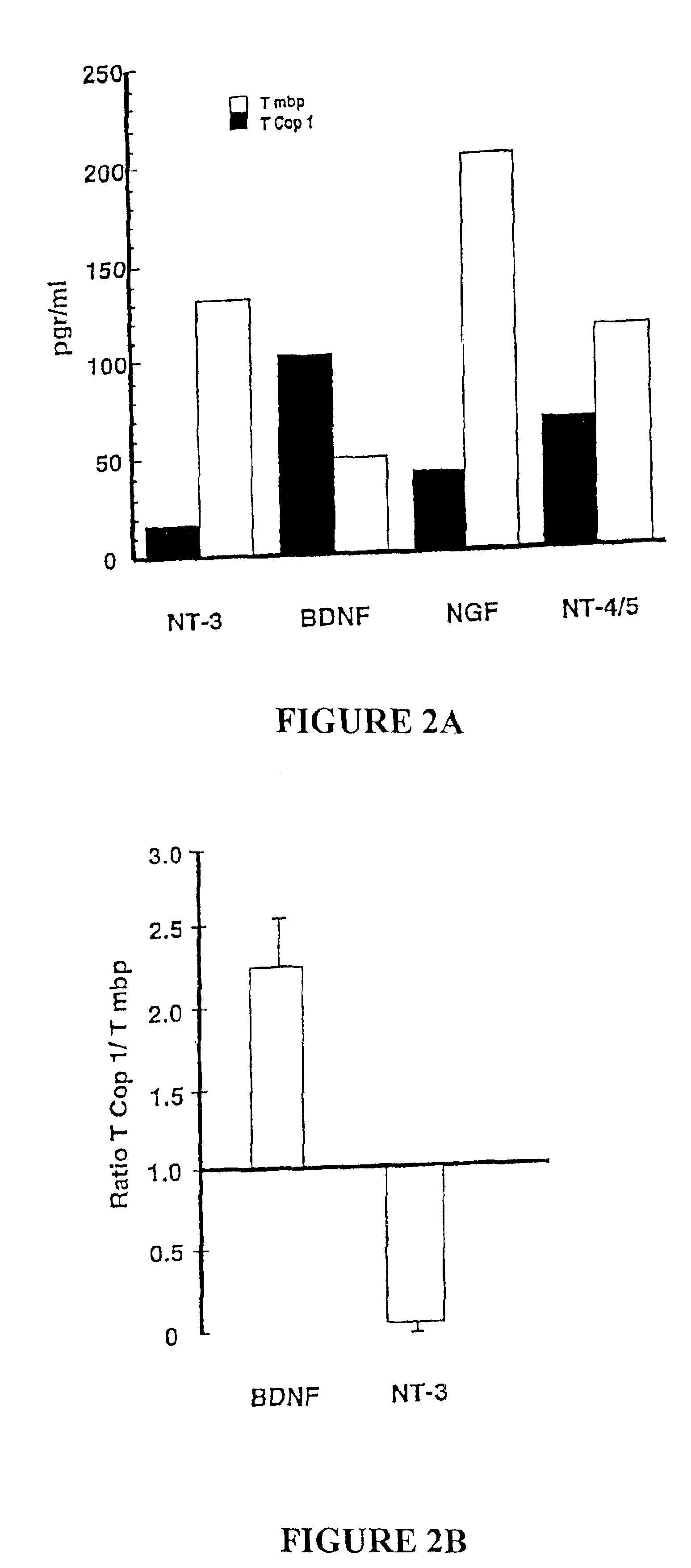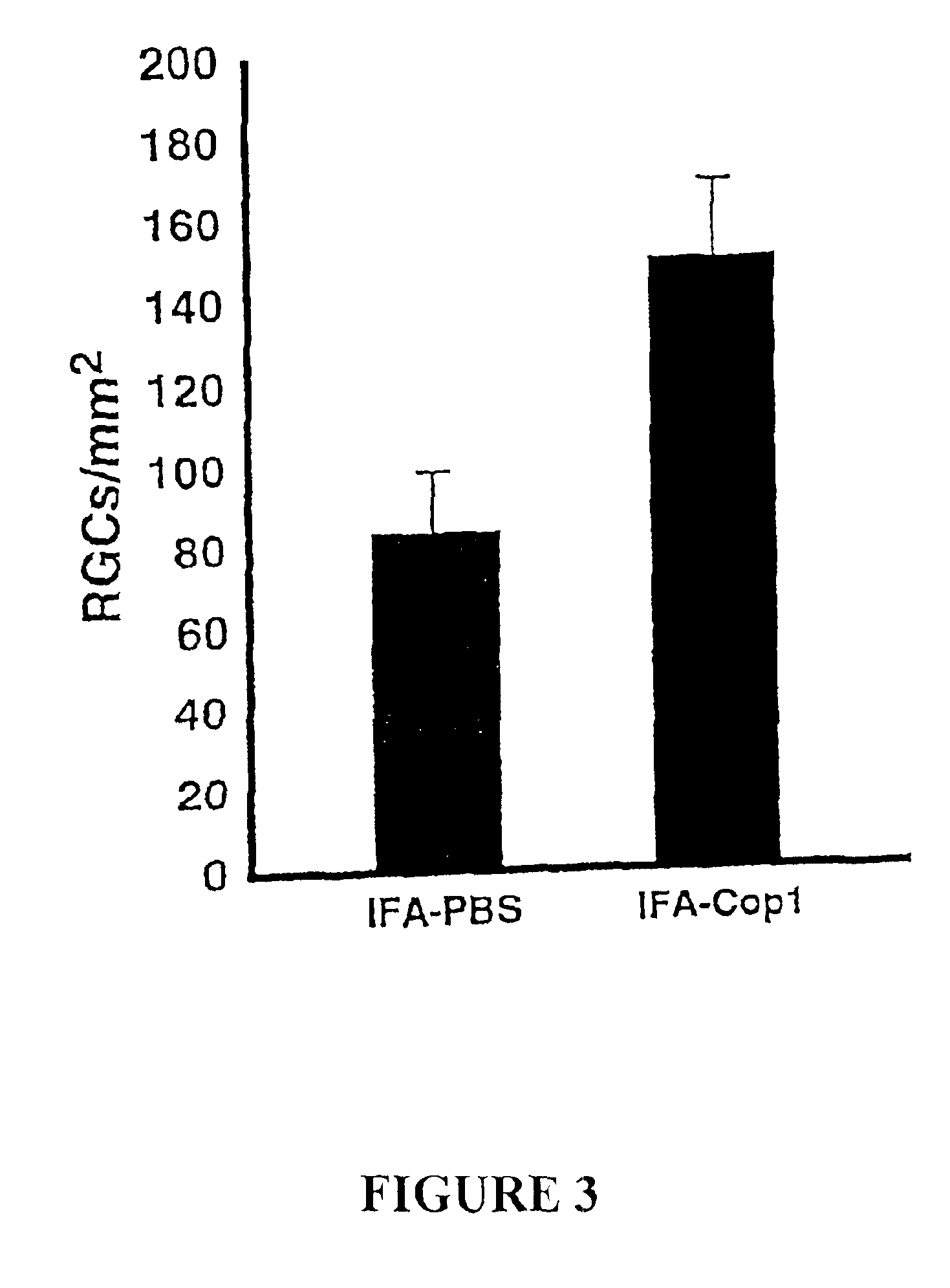Use of copolymer 1 and related peptides and polypeptides and T cells treated therewith for neuroprotective therapy
- Summary
- Abstract
- Description
- Claims
- Application Information
AI Technical Summary
Benefits of technology
Problems solved by technology
Method used
Image
Examples
example 1
Neuroprotection by Anti-Cop 1 T Cells
[0145]Adoptive Transfer of T Cells Reactive to Cop 1 is Neuroprotective in the Injured Optic Nerve
[0146]In a previous study, from the laboratory of the present inventors, it was shown that after acute CNS trauma in the rat, passive transfer of encephalitogenic T cells specific to CNS self antigens such as MBP prevents the spread of damage and thus arrests secondary degeneration (see WO 99 / 60021). Here, the neuroprotective effect of T cells reactive to Cop 1 is demonstrated, which T cells, unlike MBP-reactive T cells, are not encephalitogenic. Immediately after mild (FIG. 1A) or severe (FIG. 1B) optic nerve injury, rats were injected with PBS in IFA or with Cop 1-specific T cells in IFA. For assessment of secondary degeneration, the neurotracer dye 4-Di-10-Asp was applied to the optic nerve distal to the site of injury, two weeks after the injury. After five days, the rats were killed and their retinas were excised and flat-mounted. Labeled (survi...
example 2
Vaccination with Cop 1
[0152]Vaccination with Cop 1 Protects Optic Nerve Fibers from Secondary Degeneration
[0153]This example is intended to show that vaccination with Cop 1 in IFA, with a booster given two days later, results in an immune response strong enough for neuroprotection within the critical time window. Anesthetized rats were subjected to mild crush injury of the optic nerve, immediately vaccinated with Cop 1 in IFA, and a booster was given two days later. After two weeks the RGCs were retrogradely labeled, and five days later the rats were killed and their retinas excised. Rats vaccinated with Cop 1 in IFA showed evidence of significant neuroprotection compared to that in control rats injected with PBS in IFA (FIG. 3).
example 3
Protection from Glutamate Toxicity
[0154]Experiment 1: Vaccination with Cop 1 Protects Optic Nerve Fibers from Glutamate Toxicity
[0155]Because of the promising neuroprotection of injured nerves obtained by immunization with Cop 1, it is important to find out whether the protection would be restricted to nerve damage caused by trauma, or would be more general neuroprotection from hostile environmental conditions caused by glutamate-induced toxicity. Accordingly, the following experiment was conducted.
[0156]Immunization. C57Bl / 6J OLA mice (8-10 weeks old) were each injected with a total of 75 μg of Cop 1 emulsified with an equal volume of complete Freund's adjuvant (CFA) containing 5 mg / ml of mycobacteria H37 RA (Difco). Mice in a second group were injected with an emulsion of phosphate-buffered saline (PBS) with CFA. The emulsion, in a total volume of 0.1 ml, was injected intradermally ten days before glutamate was introduced into the retina.
[0157]Glutamate Toxicity. Ten days after im...
PUM
| Property | Measurement | Unit |
|---|---|---|
| Pressure | aaaaa | aaaaa |
| Toxicity | aaaaa | aaaaa |
Abstract
Description
Claims
Application Information
 Login to View More
Login to View More - R&D
- Intellectual Property
- Life Sciences
- Materials
- Tech Scout
- Unparalleled Data Quality
- Higher Quality Content
- 60% Fewer Hallucinations
Browse by: Latest US Patents, China's latest patents, Technical Efficacy Thesaurus, Application Domain, Technology Topic, Popular Technical Reports.
© 2025 PatSnap. All rights reserved.Legal|Privacy policy|Modern Slavery Act Transparency Statement|Sitemap|About US| Contact US: help@patsnap.com



